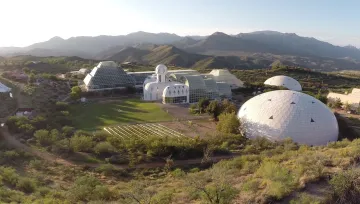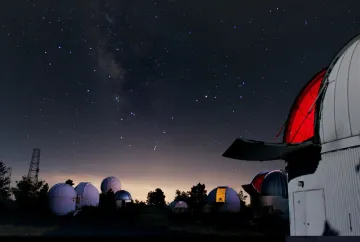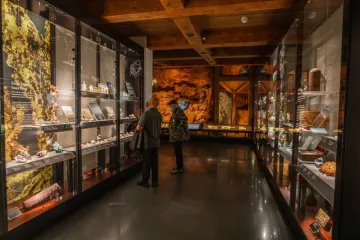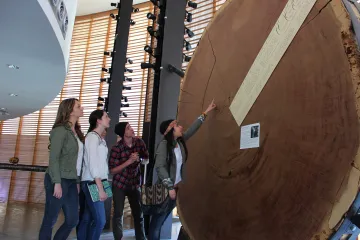The University of Arizona is known as a world leader in teaching, learning, and discovery. UArizona research expands the capacity and innovation enterprises with a focus on translating big ideas into important new knowledge and using the power of that knowledge to improve lives and communities in Arizona and across the globe. Facilities such as Tumamoc Desert Laboratory, Biosphere 2, Flandrau Science Center, UA Science Mt. Lemmon SkyCenter, the Mirror Lab, The Alfie Norville Gem and Mineral Museum, and Laboratory of Tree-Ring Research provides the communities of Arizona with the opportunity to connect with science, research, and innovation at UArizona.
View our interactive map of campus here, which includes most of the amazing outreach facilities listed below!
Tumamoc Hill

A unique combination of ecology and culture, Tumamoc is an 870-acre ecological reservation in the heart of Tucson. Its innovative, sustained, long-term environmental and archaeological studies have made it a U.S. National Historical Landmark. Tumamoc Hill offers the greater Tucson community a powerful opportunity to engage local citizens in ecology, conservation of nature, archaeology and local cultural history. The gently sloped, paved road up Tumamoc Hill gives the public one of the finest walks in the Tucson area. It rises over 700 feet from the beginning of the trail to the summit. Open to the public daily from 4 a.m. to 10 p.m. Tours of laboratory facilities are available by appointment only.
Website: Tumamoc Hill
Directions (link will take you to Google Maps)
Biosphere 2

Come tour one of the world's most unique facilities dedicated to the research and understanding of global scientific issues. Biosphere 2 serves as a laboratory for scientific studies, an arena for scientific discovery and discussion, and an valuable provider of public education. Its mission is to serve as a center for research, outreach, teaching and life-long learning about Earth, its living systems, and its place in the universe; to catalyze interdisciplinary thinking and understanding about Earth and its future; to be an adaptive tool for Earth education and outreach to industry, government, and the public; and to distil issues related to Earth systems planning and management for use by policymakers, students and the public. Tours are offered daily; see Biosphere 2's website for hours and more information.
Website: Biosphere 2
Directions (link will take you to Google Maps)
Flandrau Science Center

Located on the UA campus, Flandrau Science Center explores our universe from earth to space and everything in-between, making science come alive for all ages. Changing exhibits through the year focus on biology, energy, optics, mathematics, and more, weaving in ground-breaking UA research and revealing a world of potential STEM careers for budding scientists. Flandrau Science Center also offers southern Arizona's only fulldome planetarium theater, and their star projector can project more than 8,000 stars, recreating the visible objects of the night sky hour by hour. The UA College of Science also leads Science Discovery activities and a weekly, free, public astronomy program here. On the lower level, The UA Mineral Museum houses one of the top-five gem and mineral collections of the world. With a core collection dating back to 1892, the Mineral Museum now holds more than 26,000 specimens.
Website: Flandrau Science Center
Richard F. Caris Mirror Lab

Experience an up-close look at the facility where the U of A builds the world's largest, most complex telescope mirrors for the world's most powerful optical telescopes. These lenses that reveal the universe are created under the U of A football stadium!
Website: Richard R. Caris Mirror Lab
Mt. Lemmon SkyCenter

Located just north of Tucson on the summit of Mt. Lemmon, this unique observatory builds upon its exceptional location and the extensive knowledge-base at the University of Arizona to deliver educational adventures including: the evening StarGazing public observing program, the Astronomer Nights, an exclusive, all night, extended access to our 32-inch Schulman telescope to observe the universe with an astronomer/guide like a professional astronomer, and various special events/workshops for the public nearly every month. Private reservations are possible upon request. All programs are available by ticket purchase on our website.
Website: UA Science Mt. Lemmon SkyCenter
Alfie Norville Gem & Mineral Museum

Chris Richards/University of Arizona
The University of Arizona Alfie Norville Gem & Mineral Museum (formally known as the Mineral Museum) is a non-profit organization through the University of Arizona Foundation. The museum occupies one wing of the Historic Pima County Courthouse in Downtown Tucson, AZ. The museum's collection was recently moved from the basement of Flandrau Science Center and Space Planetarium into the newly renovated Pima County Courthouse at 115 N Church Ave Tucson, AZ 85701. The museum has 12,000 square feet of exhibit space with 3 major galleries: Mineral Evolution, Arizona Gallery, & Gem Gallery. The museum has many interactives, touchables, and digital content (video, photos, audio, and visuals).
Website: Alfie Norville Gem & Mineral Museum
Laboratory of Tree Ring Research

The Tree Ring Lab literally wrote the book on dendrochronology dating and study of annual growth rings in trees. This scientific discipline was formalized here when the lab was established in 1937. Dendrochronology is very much an interdisciplinary science, with specific application in many different research areas. These include fire history and fire ecology, paleoclimatology, archaeology, biogeography, isotope geochemistry, paleoecology, biogeochemistry, geomorphology, numerical and statistical modeling, and even public health. Tours are available by appointment only.
Website: Laboratory of Tree-Ring Research

